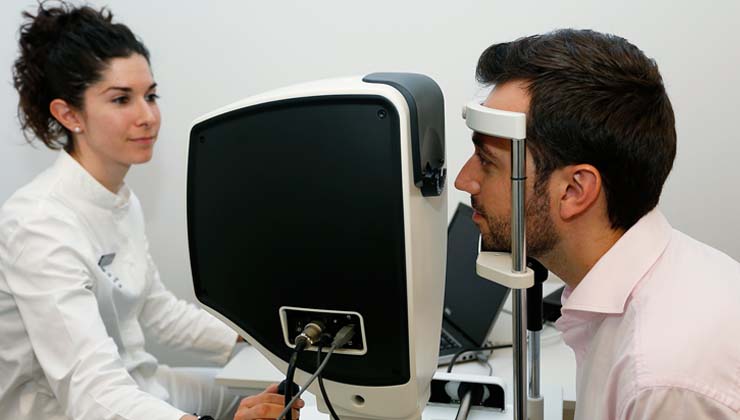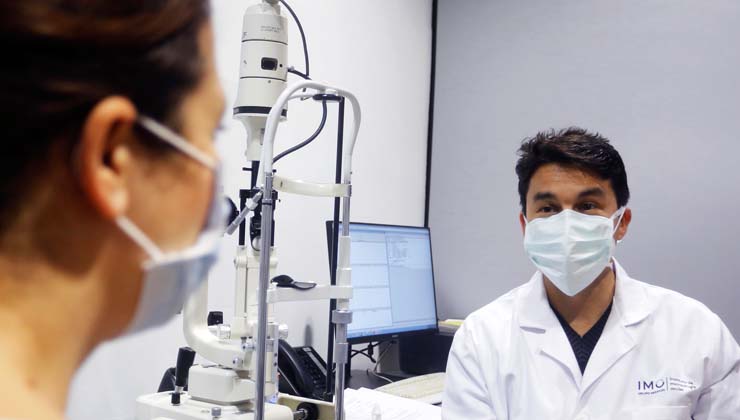The keys to dysfunctional lens syndrome
You might start with certain symptoms between the ages of 40 and 65, which in the early stages could go unnoticed and gradually progress before leading to eyesight limitations.
Most of these changes are related to dysfunctional lens syndrome, which is primarily due to the natural ageing process.
Below you will find some of the key facts about lens dysfunction syndrome.
When the eye’s “focusing lens” fails
The main cause of dysfunctional lens syndrome is the body’s ageing process, which also involves this ocular structure. “It is a natural lens that is behind the iris and that enables you to focus on objects at different distances” (Dr José L. Güell, cornea and refractive surgery expert).

Over time the crystalline lens ages, loses transparency, mobility, elasticity, and becomes opaque. Along these lines, “light is unable to enter the eye correctly, and this changes your eyesight.
Dr José L. Güell
How can I tell if I am suffering from dysfunctional lens syndrome?
The most common symptoms of dysfunctional lens syndrome are blurred vision, loss of contrast, or difficulty and changes in near vision.
However, “not all patients experience the same symptoms or at the same time”, explains Dr Güell:
- Between the ages of 42 and 50, the crystalline lens starts to change shape and ability to focus, which affects near, medium and far vision.
- After the age of 50, you might start with certain difficulties in focusing, a loss of contrast, and poor night vision.
- On reaching the age of 65, you will notice poorer vision and a loss of perception in colours, which are linked to the fact that the crystalline lens becomes more opaque, and it is during this stage that it loses its transparency and turns yellowish”, says the ophthalmologist.
2 main eye disorders: cataracts and “old eyes”
Cataracts and presbyopia or “old eyes” are two of the more frequent visual disorders linked to dysfunctional lens syndrome.
In fact, “patients normally start to notice changes in their eyesight, even before the ophthalmologist has detected a problem with the lens during a normal examination.
IMO Grupo Miranza has a piece of equipment called the HD Analyzer, which is capable of providing an early diagnosis of dysfunctional lens syndrome. In very early stages, it enables us to detect the presence of any opacity in the crystalline lens and sometimes consider correctly in with surgery”, explains Güell.

The HD Analyzer test allows early detection of lens disorders
The ophthalmologist will therefore normally include this test in the routine check ups for patients suspected of suffering from some kind of lens dysfunction that cannot be measured using other resources.
Tailor-made solutions for each vision problem
Glasses
Dysfunctional lens syndrome can often be treated effectively with glasses: “This option is convenient for patients and there are many different types of lens: monofocal, bifocal, progressive or occupational, as well as filters that are extremely helpful”, indicates the ophthalmologist.

Lens dysfunction syndrome can be effectively treated with glasses
Presbyopia surgery
For patients not wanting to rely on glasses, refractive surgery is also a possibility to fully or partially offset presbyopia. Furthermore, “we can also correct other refractive defects, if required, such as myopia, hyperopia or astigmatism”, adds Güell.
For patients not wanting to rely on glasses, refractive surgery is also a possibility
Cataract surgery
In terms of cataracts, the solution always involves surgery and consists of removing the ageing lens and replace it with an intraocular lens to do the same job.

El tratamiento de la catarata es quirúrgico y consiste en reemplazar el cristalino por una lente intraocular
Along these lines, “IMO Grupo Miranza has a wide range of intraocular lenses for presbyopia and cataract surgeries (monofocal, multifocal, bifocal and trifocal). What is more, each one can benefit from what most suits the vision requirements in question, although always on prescription and with medical advice”, concludes Güell.
The device that helps each patient choose the ideal intraocular lens
IMO Grupo Miranza has recently incorporated a new device, Vivior Monitor, which can be used on some of the patients who are to undergo surgeries involving intraocular lens implantation at the Institute (primarily presbyopia and cataracts) and that indicates the most suitable type for each person
Vivior Monitor is a small appliance that is worn on the arms of the patient’s glasses for 36 h. The device collects information on the patient’s everyday activities, measuring the distances and lighting involved, along with the extent to which the head is tilted. All this information is collected in software that in turn provides data that enables the ophthalmologist to personalise the most suitable type of lens in each case.

New technologies such as the Vivior Monitor enable us to offer a better quality of life and optimal vision results for our patients.
Dr Jorge Cazal, cornea, cataract and refractive surgery expert
This device is used in addition to a comprehensive eye examination and other diagnostic tests that are essential in providing information on all the details of the patient’s eye and of the intraocular lens to be implanted.

